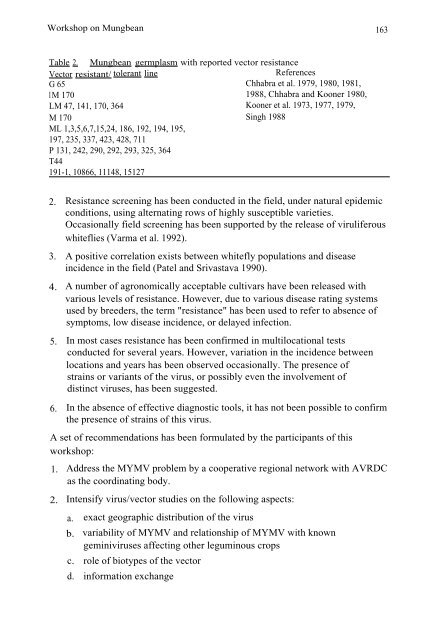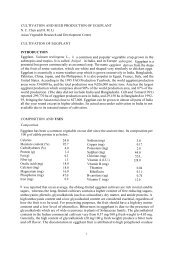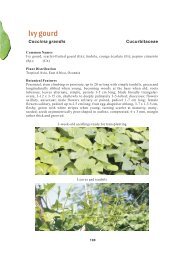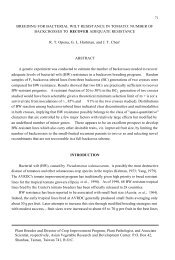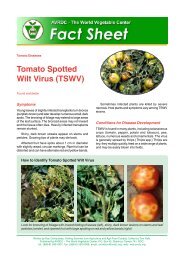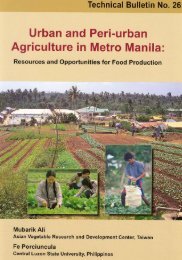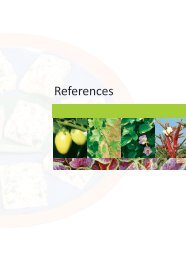Mungbean Yellow Mosaic Virus in the AVRDC Mungbean ...
Mungbean Yellow Mosaic Virus in the AVRDC Mungbean ...
Mungbean Yellow Mosaic Virus in the AVRDC Mungbean ...
You also want an ePaper? Increase the reach of your titles
YUMPU automatically turns print PDFs into web optimized ePapers that Google loves.
Workshop on <strong>Mungbean</strong> 163<br />
Table 2. <strong>Mungbean</strong> germplasm with reported vector resistance<br />
Vector resistant/ tolerant l<strong>in</strong>e References<br />
G 65 Chhabra et al. 1979, 1980, 1981,<br />
IM 170 1988, Chhabra and Kooner 1980,<br />
LM 47, 141, 170, 364 Kooner et al. 1973, 1977, 1979,<br />
M 170 S<strong>in</strong>gh 1988<br />
ML 1,3,5,6,7,15,24, 186, 192, 194, 195,<br />
197, 235, 337, 423, 428, 711<br />
P 131, 242, 290, 292, 293, 325, 364<br />
T44<br />
191-1, 10866, 11148, 15127<br />
2. Resistance screen<strong>in</strong>g has been conducted <strong>in</strong> <strong>the</strong> field, under natural epidemic<br />
conditions, us<strong>in</strong>g alternat<strong>in</strong>g rows of highly susceptible varieties.<br />
Occasionally field screen<strong>in</strong>g has been supported by <strong>the</strong> release of viruliferous<br />
whiteflies (Varma et al. 1992).<br />
3. A positive correlation exists between whitefly populations and disease<br />
<strong>in</strong>cidence <strong>in</strong> <strong>the</strong> field (Patel and Srivastava 1990).<br />
4. A number of agronomically acceptable cultivars have been released with<br />
various levels of resistance. However, due to various disease rat<strong>in</strong>g systems<br />
used by breeders, <strong>the</strong> term "resistance" has been used to refer to absence of<br />
symptoms, low disease <strong>in</strong>cidence, or delayed <strong>in</strong>fection.<br />
5. In most cases resistance has been confirmed <strong>in</strong> multilocational tests<br />
conducted for several years. However, variation <strong>in</strong> <strong>the</strong> <strong>in</strong>cidence between<br />
locations and years has been observed occasionally. The presence of<br />
stra<strong>in</strong>s or variants of <strong>the</strong> virus, or possibly even <strong>the</strong> <strong>in</strong>volvement of<br />
dist<strong>in</strong>ct viruses, has been suggested.<br />
6. In <strong>the</strong> absence of effective diagnostic tools, it has not been possible to confirm<br />
<strong>the</strong> presence of stra<strong>in</strong>s of this virus.<br />
A set of recommendations has been formulated by <strong>the</strong> participants of this<br />
workshop:<br />
1. Address <strong>the</strong> MYMV problem by a cooperative regional network with <strong>AVRDC</strong><br />
as <strong>the</strong> coord<strong>in</strong>at<strong>in</strong>g body.<br />
2. Intensify virus/vector studies on <strong>the</strong> follow<strong>in</strong>g aspects:<br />
a. exact geographic distribution of <strong>the</strong> virus<br />
b. variability of MYMV and relationship of MYMV with known<br />
gem<strong>in</strong>iviruses affect<strong>in</strong>g o<strong>the</strong>r legum<strong>in</strong>ous crops<br />
c. role of biotypes of <strong>the</strong> vector<br />
d. <strong>in</strong>formation exchange


